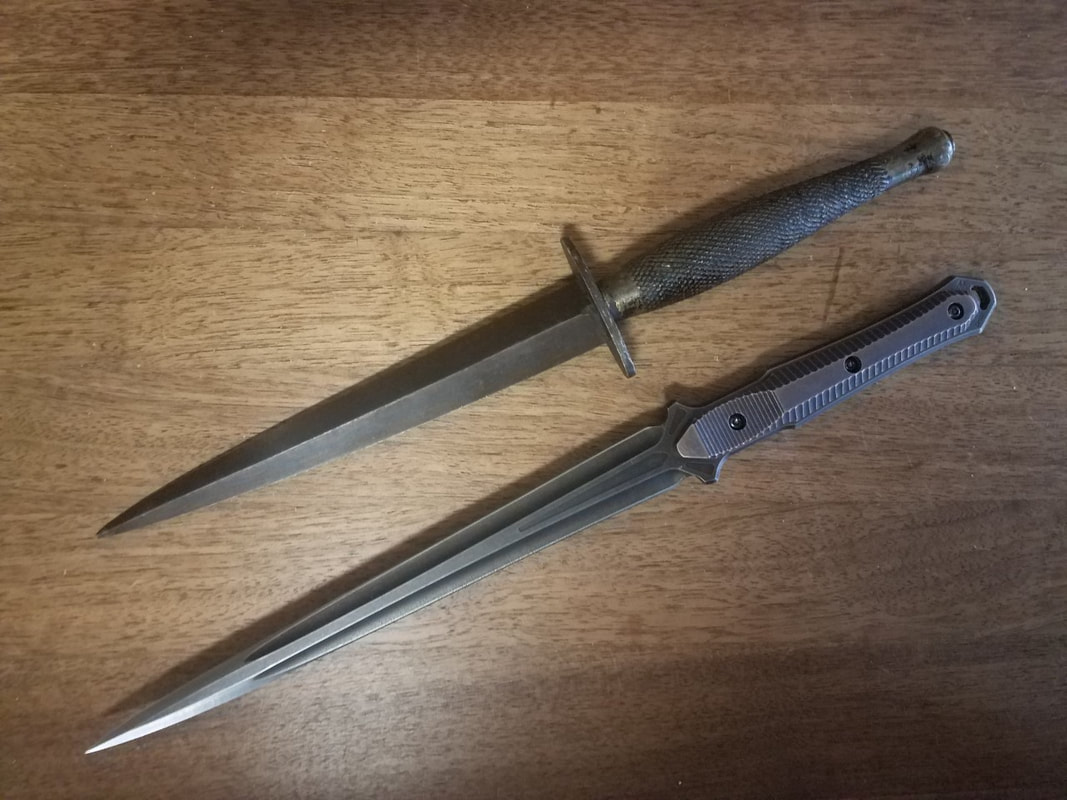The Long and Short of it:
The knife that you choose will determine the techniques that you use. This is a mantra that I used in my last book, and in this book we will go into greater detail of how the size and format of a knife actually does affect knife usage. No, bigger is not always better! Even in a combat theater it is generally impractical to carry a knife with a blade over 8 inches long[1]. Today’s man-at-arms is often burdened with a rucksack weighing sixty pounds or more along with his rifle and other gear. The last thing a serviceman needs is a clumsy, three-pound, sixteen inch-long, "combat" knife slapping at his side as he races into a firefight or climbs into his armored Hum-Vee or Bradley Fighting Vehicle.
For the purposes of this blog I have divided knives into the following sizes.
· Large Knife: blade lengths of 7-10 inches or longer
· Medium Knife: blade lengths of 5-6 inches
· Small Knife: blade lengths of 3-5 inches or less
Over the years I have vacillated, trying to decide upon the ideal blade size for a pure fighting knife. Despite the sizes just given I have finally concluded that for me, in a true one-on-one knife duel, I would prefer to use a knife with a blade length between 9.5 and 10 inches. As I said before, this is not a practical sized knife to be carried on a daily basis. For daily military use I would still recommend 7-8 inch blades, and for concealed, every day carry knives I might prefer 3 to 5 inch blades (a compromise partly due to knife laws). Chas Clements, a kuntao stylist, in a 1994 article[2] said that,
“By and large, the large knife is best for fighting, all other choices are a compromise.” He continued on to say that “The small knife is a compromise of stealth, fashion, or utility.”
I know there are many knifemakers and authors alike who will take strong exception to my choices of sizes and Mr. Clements' advice. That’s OK, we all have a right to our own opinions. I also recognize that there will be occasions where fighters may need to resort to using bigger instruments of destruction, such as bolos, machetes, or even swords. An acquaintance - who had been in Vietnam during some of the last bitter fighting - once told me that he never got into a knife-fight: “But I sure messed-up some people with an entrenching tool.” There you go. All you can do is weigh my suggestions and other’s opinions against your own experience and skills and decide for yourself what size knife common sense dictates for you. By the way, just in case you were considering buying an entrenching tool for self-defense, they are extremely hard to carry concealed. This doesn’t mean you might not want to throw one under the car seat for those days you might get stuck in snow or mud, or need to take off the top of some low-life’s or Zombies head in a violent encounter. There is a full range of techniques designed especially for these tools taught by the Russian Spetznaz. A good entrenching tool for this type of defense (and general emergency situations) is available from Cold Steel™ or off Ebay.
[1] Many combat units prohibit their members from carrying a private purchase knife of any size.
[2] Heartless Monkey Knife, Chas Clements 1994 internet article
The photo is of two "Argentines" deigned by Laci Szabo/James Keating. Note the Spanish Notch in the blade's edge, something James A. Keating re-established on fighting knives. The "notch" is a blade-catcher and was something found on Spanish fighting knives and adapted to some Bowies. These are a light, fast blade for defense or offense.




 RSS Feed
RSS Feed
